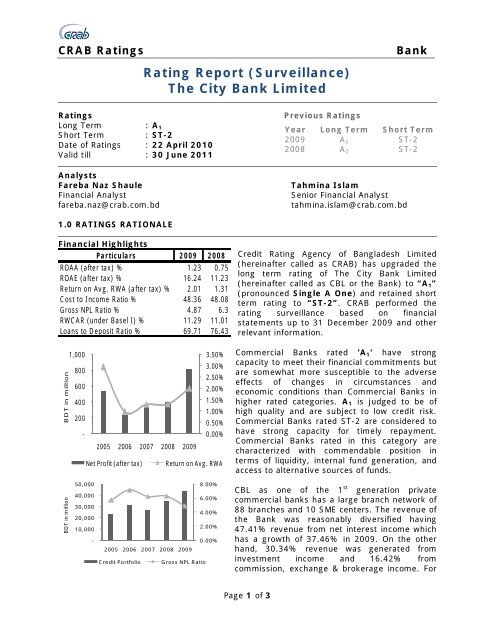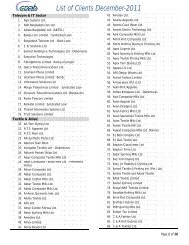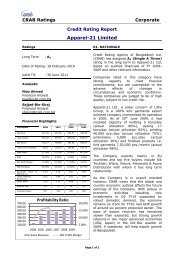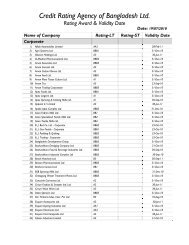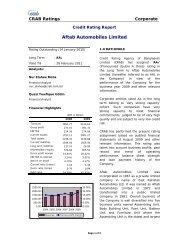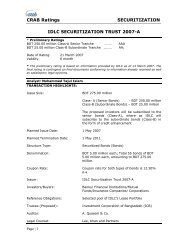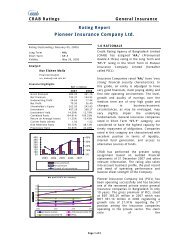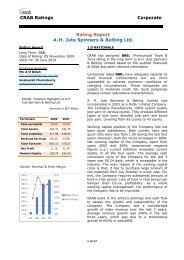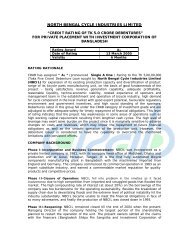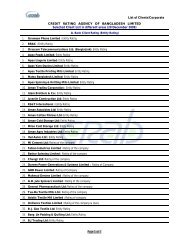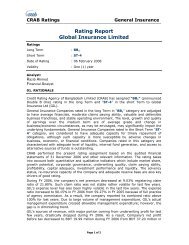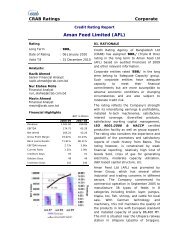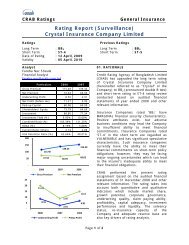The City Bank Limited - Credit Rating Agency of Bangladesh
The City Bank Limited - Credit Rating Agency of Bangladesh
The City Bank Limited - Credit Rating Agency of Bangladesh
Create successful ePaper yourself
Turn your PDF publications into a flip-book with our unique Google optimized e-Paper software.
CRAB <strong>Rating</strong>s<br />
<strong>Rating</strong> Report (Surveillance)<br />
<strong>The</strong> <strong>City</strong> <strong>Bank</strong> <strong>Limited</strong><br />
<strong>Bank</strong><br />
<strong>Rating</strong>s<br />
Long Term : A 1<br />
Short Term<br />
: ST-2<br />
Date <strong>of</strong> <strong>Rating</strong>s : 22 April 2010<br />
Valid till : 30 June 2011<br />
Analysts<br />
Fareba Naz Shaule<br />
Financial Analyst<br />
fareba.naz@crab.com.bd<br />
Previous <strong>Rating</strong>s<br />
Year Long Term Short Term<br />
2009 A 2 ST-2<br />
2008 A 2 ST-2<br />
Tahmina Islam<br />
Senior Financial Analyst<br />
tahmina.islam@crab.com.bd<br />
1.0 RATINGS RATIONALE<br />
Financial Highlights<br />
Particulars 2009 2008<br />
ROAA (after tax) % 1.23 0.75<br />
ROAE (after tax) % 16.24 11.23<br />
Return on Avg. RWA (after tax) % 2.01 1.31<br />
Cost to Income Ratio % 48.36 48.08<br />
Gross NPL Ratio % 4.87 6.3<br />
RWCAR (under Basel I) % 11.29 11.01<br />
Loans to Deposit Ratio % 69.71 76.43<br />
BDT in million<br />
1,000<br />
800<br />
600<br />
400<br />
200<br />
-<br />
2005 2006 2007 2008 2009<br />
Net Pr<strong>of</strong>it (after tax)<br />
3.50%<br />
3.00%<br />
2.50%<br />
2.00%<br />
1.50%<br />
1.00%<br />
0.50%<br />
0.00%<br />
Return on Avg. RWA<br />
<strong>Credit</strong> <strong>Rating</strong> <strong>Agency</strong> <strong>of</strong> <strong>Bangladesh</strong> <strong>Limited</strong><br />
(hereinafter called as CRAB) has upgraded the<br />
long term rating <strong>of</strong> <strong>The</strong> <strong>City</strong> <strong>Bank</strong> <strong>Limited</strong><br />
(hereinafter called as CBL or the <strong>Bank</strong>) to “A 1 ”<br />
(pronounced Single A One) and retained short<br />
term rating to “ST-2”. CRAB performed the<br />
rating surveillance based on financial<br />
statements up to 31 December 2009 and other<br />
relevant information.<br />
Commercial <strong>Bank</strong>s rated 'A 1 ' have strong<br />
capacity to meet their financial commitments but<br />
are somewhat more susceptible to the adverse<br />
effects <strong>of</strong> changes in circumstances and<br />
economic conditions than Commercial <strong>Bank</strong>s in<br />
higher rated categories. A 1 is judged to be <strong>of</strong><br />
high quality and are subject to low credit risk.<br />
Commercial <strong>Bank</strong>s rated ST-2 are considered to<br />
have strong capacity for timely repayment.<br />
Commercial <strong>Bank</strong>s rated in this category are<br />
characterized with commendable position in<br />
terms <strong>of</strong> liquidity, internal fund generation, and<br />
access to alternative sources <strong>of</strong> funds.<br />
BDT in million<br />
50,000<br />
40,000<br />
30,000<br />
20,000<br />
10,000<br />
-<br />
8.00%<br />
6.00%<br />
4.00%<br />
2.00%<br />
0.00%<br />
2005 2006 2007 2008 2009<br />
<strong>Credit</strong> Portfolio Gross NPL Ratio<br />
CBL as one <strong>of</strong> the 1 st generation private<br />
commercial banks has a large branch network <strong>of</strong><br />
88 branches and 10 SME centers. <strong>The</strong> revenue <strong>of</strong><br />
the <strong>Bank</strong> was reasonably diversified having<br />
47.41% revenue from net interest income which<br />
has a growth <strong>of</strong> 37.46% in 2009. On the other<br />
hand, 30.34% revenue was generated from<br />
investment income and 16.42% from<br />
commission, exchange & brokerage income. For<br />
Page 1 <strong>of</strong> 3
CRAB <strong>Rating</strong>s<br />
<strong>Bank</strong><br />
the last five years CBL had experienced a high cost to income ratio which was 48.36% in<br />
2009. On the other hand, due to high growth in operating income the staff cost to income<br />
ratio has decreased to 27.60% from 30.789% in 2009.<br />
<strong>The</strong> net pr<strong>of</strong>it margin and return on average assets also increased in 2009 due to high<br />
growth in net pr<strong>of</strong>it. On the other hand, return on average RWA also increased to 2.01% in<br />
2009 from 1.31% in 2008. During this period the return on average equity also increased<br />
even after decrease in leverage multiplier.<br />
In 2009, 56.87% <strong>of</strong> its assets comprised loans and advances which has a growth <strong>of</strong> 26.34%<br />
and this loans were well diversified among different industries. In 2009 <strong>Bank</strong>’s top 50 large<br />
loans exposures consisted 40.08% <strong>of</strong> total loans & advances.<br />
<strong>Bank</strong>’s NPL in 2009 was BDT 2,116.96 million which was 4.87% <strong>of</strong> total loans & advances<br />
(2008: 6.30%). In 2009 CBL was able to decrease the fresh NPL generation, which was<br />
3.46% <strong>of</strong> total loans & advances (2008:6.76%). At the same time in this period the amount<br />
<strong>of</strong> rescheduling and write <strong>of</strong>f also decreased as percentage <strong>of</strong> total loans. On the other<br />
hand, cash recovery as percentage <strong>of</strong> total loans also decreased to 1.14% in 2009 from<br />
1.22% in 2008. Of the total NPL 70.13% was in bad & loss category. On the other hand,<br />
<strong>Bank</strong>’s special mention account (SMA) to loans & advances increased to 3.02% in 2009<br />
which was 1.47% in 2008. However, the <strong>Bank</strong> had maintained surplus provision against the<br />
required provision for both classified and unclassified loans.<br />
<strong>The</strong> <strong>Bank</strong>’s risk weighted capital adequacy ratio was 11.29% which was 11.01% as against<br />
regulatory requirement <strong>of</strong> 10% (under Basel I). On the other hand, under Basel II<br />
framework capital adequacy ratio reduced to 7.95% for the same period mainly because <strong>of</strong><br />
these loans were considered unrated. However, the Board has decided to increase the paid<br />
up capital by issuing right shares subject to the approval <strong>of</strong> shareholders in the EGM and<br />
SEC which will provide more capital cushion for the <strong>Bank</strong>.<br />
<strong>The</strong> loans & advances to deposit ratio <strong>of</strong> the <strong>Bank</strong> was 69.71% at the end <strong>of</strong> 2009. On the<br />
other hand the monthly average <strong>of</strong> loans & advances to deposit ratio was 77.92%. <strong>The</strong> <strong>Bank</strong><br />
was net borrower to the call market throughout 2009 except in May and December. <strong>The</strong><br />
<strong>Bank</strong>’s asset liability maturity bucket shows except for 1 to 12 months time interval the<br />
<strong>Bank</strong> possessed positive net liquidity gap. But cumulative net liquidity gap <strong>of</strong>fset the<br />
negative position in 1 to 3 months time interval. <strong>The</strong> <strong>Bank</strong>’s liquid assets to total deposit &<br />
borrowings ratio increased to 37.49% in 2009 from 32.86% in 2008.<br />
<strong>The</strong> ratings also take into account the qualitative factors. <strong>The</strong> rating considers the credit<br />
policy and approval process practices are in place to protect the quality <strong>of</strong> the portfolio. CBL<br />
is among the very few local banks in which under their centralized process all types <strong>of</strong><br />
transactions and monitoring are being done from CAD, which had been previously executed<br />
in branches.<br />
Under the restructuring process <strong>of</strong> the <strong>Bank</strong> formation <strong>of</strong> new departments and reshuffling<br />
the human resources was a big challenge. In 2009 the numbers <strong>of</strong> staff joined and left CBL<br />
were 483 and 193 respectively.<br />
CBL has gone through an enormous transformation in case <strong>of</strong> MIS during 2009. Networking<br />
and server hardware devices have been procured and implemented to support operations <strong>of</strong><br />
online branches, POS’s and ATMs. <strong>The</strong> milestone <strong>of</strong> any branch banking has been<br />
completed. <strong>The</strong>y have taken initiatives to upgrade the Disaster Recovery Site (DRS). A big<br />
Page 2 <strong>of</strong> 3
CRAB <strong>Rating</strong>s<br />
<strong>Bank</strong><br />
achievement has been the introduction <strong>of</strong> the internet banking (i-<strong>Bank</strong>) and SMS banking.<br />
CBL has planned to maintain and update library <strong>of</strong> industry and market information.<br />
During 2009 the <strong>Bank</strong> has opened 5 new branches and 5 SME centers. It has also raised its<br />
no <strong>of</strong> total ATMs to 50 in 2009 from 22 in 2008. In 2009 the <strong>Bank</strong> has launched American<br />
Express card and as a prerequisite <strong>of</strong> which it has opened a 24 hour call center. In 2009 the<br />
<strong>Bank</strong> has inaugurated its own new corporate head <strong>of</strong>fice at Gulshan Avenue. In 2009 the<br />
<strong>Bank</strong> obtained Off-shore banking unit permission which has started its operation at the<br />
beginning <strong>of</strong> 2010. <strong>The</strong> <strong>Bank</strong> currently has 4 brokerage house outlets. <strong>The</strong> Board <strong>of</strong><br />
Directors <strong>of</strong> the <strong>Bank</strong> has decided to convert its Brokerage Business Division to a fully<br />
owned subsidiary company named as “<strong>City</strong> Brokerage <strong>Limited</strong>” subject to obtaining<br />
permission from concerned regulatory authority.<br />
In 2009 CBL participated in a number <strong>of</strong> loan syndication arrangements as the lead arranger<br />
in energy, export oriented ceramic manufacturing and petrochemical industries. On the<br />
other hand, the <strong>Bank</strong> has introduced cash management service for both corporate and<br />
institutional clients. <strong>The</strong> <strong>Bank</strong> has a plan to run the cash management business in a more<br />
organized way by developing new collection product and payment product.<br />
Page 3 <strong>of</strong> 3


